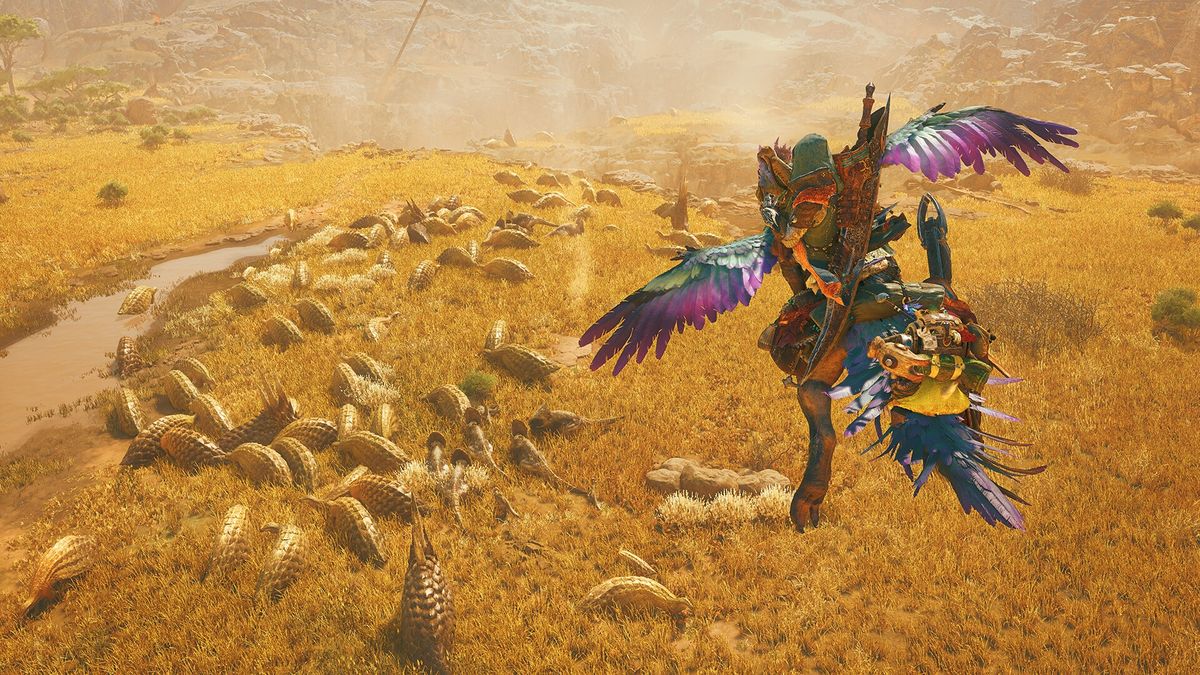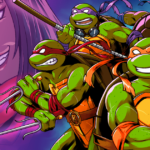Why you can trust TechRadar
We spend hours testing every product or service we review, so you can be sure you’re buying the best. Find out more about how we test.
Monster Hunter Wilds has some rather big shoes to fill. For one, it’s the sequel to the record-breaking blockbuster that was Monster Hunter World, a game that saw the long-running, and oftentimes niche franchise reach a whole new group of altogether more mainstream gamers. It also follows Monster Hunter Rise, which, while not as big as World, was extremely successful as an originally exclusive Nintendo Switch game, and introduced a host of new traversal systems.
Review info
Platform reviewed: PS5 Pro
Available on: Xbox Series X, Xbox Series S, PC, PS5
Release date: February 28, 2025
In many ways, Wilds has had to walk a tightrope between the approaches showcased in previous games, providing something for the new fans, while appealing to those that have stuck around over the past 20 years. By streamlining the formula that shined bright in Monster Hunter World, and by finally offering a seamless open world, Monster Hunter Wilds manages to hit all of the right notes, while avoiding some of the more frustrating elements that have plagued the series since its inception.
Let’s skip to the good part
Loading up a brand new Monster Hunter game is usually a mixed experience. To truly access the really good stuff, that being the High Rank endgame content, you need to first beat the campaign. In the past couple of games, this has been easy enough, though the shoehorned systems present in Monster Hunter Rise (Rampage Mode), and Monster Hunter World (colossal Elder monster battles) really dragged things out, extending the runtime of stories that were fun, but forgettable.
Monster Hunter Wilds is an entirely different beast with regards to its campaign, which is streamlined, slight, and punchy. For one, there’s no ‘gimmick’ to speak of, with the headline feature being the seamless open world with dynamic seasons and wildlife. There are no on-rails giant monster battles, no filler quests spent in quasi-tower-defense modes, just epic monster hunts, one after the other. One annoying side character aside, this is the best Monster Hunter campaign ever, punctuated by a final boss fight that’s already among my all-time favorites in all of gaming.
Best bit
The reverence that Monster Hunter Wilds shows for every single one of its monsters shines through from the very beginning. Doshaguma, a monster featured in the beta, and one that wasn’t particularly interesting at first, is introduced into the main game with an exhilarating sequence, as lightning sparks all around, and other monsters come to join in on the hunt. Several moments like these bookend other major hunts in the campaign, with every single main fight being a show-stopping event.
The Monster Hunter Wilds campaign is a globe-trotting adventure that encourages you to spend as little time in your base camp as possible. There’s still fun to be found in crafting new gear, building new loadouts, and specializing your Item Pouch, but largely, you’ll be encouraged to be out and about as much as possible.
One casualty of expanding the open world to include multiple hub villages is that the main hub, which you’ll have seen if you played the beta, doesn’t really measure up to the more dedicated locales like Astera, found in previous games. Much more focus has been applied to Pop-Up Camps, with Monster Hunter Wilds once again encouraging the player to set out and claim small pieces of the world outside, rather than get too settled at the ramshackle Base Camp in the Windward Plains. It’s a strange choice, though one that does tie into the game’s overall mantra. Cooking a meal in your camp just isn’t as fun as watching a team of Palico chefs preparing dishes for you back at Kamura Village or Astera, however.
Someone call Attenborough
The vast open world of Monster Hunter Wilds is the main draw that sets the game aside from its predecessors. For the first time in the series, the map is an interconnected, seamless, and dynamic one. From camp, to hunt, to Field Investigations, there are no menus or loading screens getting in your way as you adventure. Of the handful of different regions that make up the world around you, each is visually distinct from one another, fostering its own specific collection of flora, fauna, and resources. Not only that but there are seasons to reckon with here as well. Fallow will strip away some of the biodiversity of a region, turning areas like the Windward Plains into dusty deserts, populated by only the hardiest of creatures.
Inclemency then rolls in, bringing sandstorms, riling up certain insects to boost passive effects that can be used on a hunt, and in some cases, completely changing the landscape. After the storm clouds fade, the season of Plenty comes about, and let me tell you, the change in conditions are seriously impressive. Gone are the barren dry lands of the Fallow, and the cloudy skies of Inclemency, as you look out over an Edenic environment teeming with creatures.
The campaign does a masterful job of leading you through this cycle for the first time, and the sheer dynamism of the world never really loses its charm. This doubling down on creating a living, breathing natural world follows the path laid in Monster Hunter World. This time though, the variety in the life that occupies each region is genuinely breathtaking.
Once I was given the freedom to explore at my leisure, I spent hours simply riding through each region, watching as small monsters and other endemic animals went about their routines. Pink-furred apes snooze peacefully in the sun, small birds can be seen riding on the backs of large reptiles, pecking and pruning as they go. Whether you’re there to witness it or not, there’s a natural cycle to the world of Wilds, and meticulous detail, from the huge raptors that soar in the sky, to the lines of tiny leaf-cutting ants that walk in formation across the branches of trees. You can practically hear David Attenborough narrating the whole thing.
Focus, Hunter
Monster Hunter games are rarely praised for their graphical fidelity, as they tend to put more resources into dynamic worlds and overlapping systems than boosting the resolution. Thankfully, Monster Hunter Wilds is very impressive to behold, though like a lot of other modern games this generation, does have some issues with looking washed out in certain environments. Some regions like the forest are impossibly dense, and I was regularly taken aback by just how many small monsters could be on screen at once. In fact, entire herds can be seen in some moments, running alongside large monsters as you give chase.
Performance-wise, the game runs smoothly on PlayStation 5 Pro, especially in the Prioritize Framerate mode. There is quite a hit to visual fidelity, but with how frenetic fights can get, you’re going to want those 60 frames per second (fps). What Monster Hunter Wilds may lack slightly in pure graphical prowess, it more than makes up for in the way its seasons change the world. Atmospheric fog effects, dust clouds that precede huge sandstorms, and puddles that follow the heavy rain all look spectacular, refreshing the palette with a complete change of scenery just before any one locale starts to overstay its welcome.
Should I play Monster Hunter Wilds?
Play it if…
Don’t play it if…
Accessibility
Monster Hunter Wilds offers some accessibility options, namely in button mapping and colorblindness assistance (Trichromatic, Protanope, Deuteranope, Tritanope), but its convoluted control schemes could be tricky for some. Though the series has definitely streamlined its approach to combos for certain weapons, you’re still going to be managing a bunch of quick menus, weapon gauges, and aiming reticles at once. A simplified control scheme would be a welcome addition, especially for more complicated weapons like the Insect Glaive, which require multiple buttons to be pressed and held at once to execute moves. There are some basic auditory settings, motion sickness reduction, and an arachnophobia mode as well.
How I reviewed Monster Hunter Wilds
I played Monster Hunter Wilds for 30 hours on the PlayStation 5 Pro. During that time I completed the campaign (in around 18 hours) and then cleared through the start of the post-game content. In general, I tried to tackle side quests as they appeared and set out into each new region to explore for a while after they unlocked. There were three graphics options available during the pre-release period: Prioritize Resolution, Balanced, and Prioritize Framerate. I played the vast majority of the game in the Prioritize Framerate mode, keeping it at a solid 60fps.
On PlayStation 5 Pro, I played the game using a 4K Samsung TV (Samsung 43-inch RU7400 Dynamic). I used a PS5 DualSense Edge controller, with the Razer Blackshark V2 gaming headset connected via the controller port. Having started with Monster Hunter Generations Ultimate on Nintendo Switch, I’ve poured hundreds of hours into Monster Hunter since. Monster Hunter Rise is where I spent the most time, and I absolutely consider it to be one of the best Switch games, but recently I’ve gone back to Monster Hunter World to prep for the release of Wilds. In addition to being a fan, I’ve produced hundreds of Monster Hunter guides over the years, covering everything from the best weapon builds, to where to track down rare resources.
First reviewed February 2025
Read the full article here














